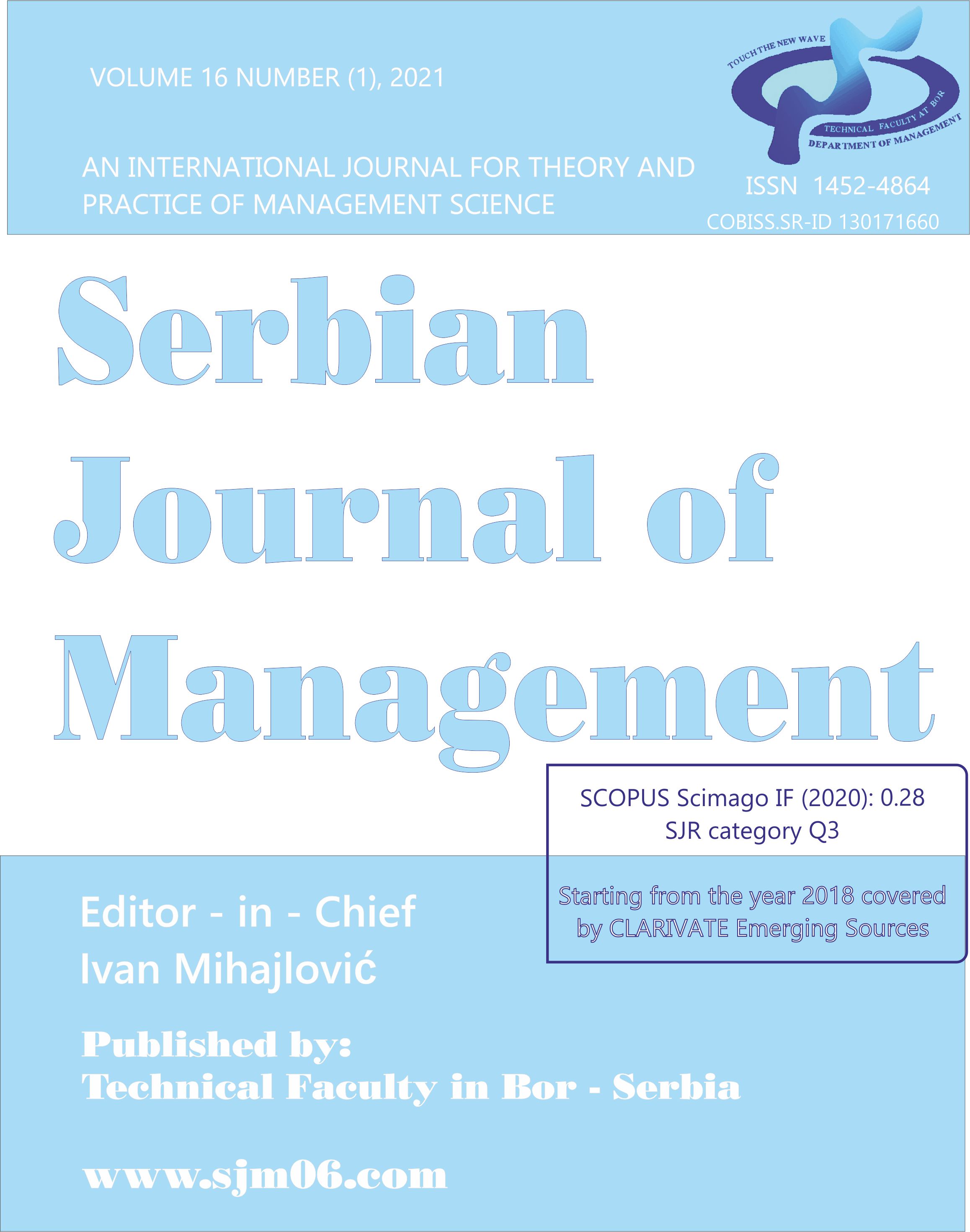Utilization of shopfloor management as a tool for communication and knowledge sharing in the framework of LEAN logistics – a case study
Abstract
The study investigates whether establishing of the shopfloor management in the company is beneficial for the company or not even in difficult conditions (food production with BRC standards of production, presence of foreigners, agency employees). A qualitative research based on detailed long-term observation the real process of planning and establishing the shopfloor management in the company was used, as well as interviews with industrial engineers, first line managers, blue-collar workers, and shopfloor management practitioners. The company was chosen for this case study on purpose. The findings say it was good to establish SFM in the company. In spite of obstacles, the utilization of machines increased by 20% and one machine (out of 12) could be sold due to redundancy. The need for human capital decreased, the number of scraps decreased, and the cooperation improved.
References
Bortolotti, T., Boscari, S., & Danese, P. (2015). Successful lean implementation: Organizational culture and soft lean practices. International Journal of Production Economics, 160, 182–201.
Chi Anh, P., Zeng, J., & Matsui, Y. (2013). Shop‐floor communication and process management for quality performance: An empirical analysis of quality management. Management Research Review, 36 (5), 454–477.
de Vries, R. E., Bakker-Pieper, A., & Oostenveld, W. (2010). Leadership = Communication? The Relations of Leaders’ Communication Styles with Leadership Styles, Knowledge Sharing and Leadership Outcomes. Journal of Business and Psychology, 25 (3), 367–380.
Uwe, D., Belz, T., & Jäger, F. (2014). Shopfloor Management in control circuit of the GPS implementation. ZWF Zeitschrift Für Wirtschaftlichen Fabrikbetrieb, 109(1–2), 20–25. (In German). https://doi.org/10.3139/104.111081
Duarte, F., Madeira, M. J., Moura, D.C., Carvalho, J., & Moreira, J.R.M. (2017). Barriers to innovation activities as determinants of ongoing activities or abandoned. International Journal of Innovation Science, 9 (3), 244–264.
Hanenkamp, N. (2013). The Process Model for Shop Floor Management Implementation. Advances in Industrial Engineering and Managemen, 2 (1) 40-46.
Hertle, C., Siedelhofer, C., Metternich, J., & Abele, E. (2015). The next generation shop floor management-how to continuously develop competencies in manufacturing environments. The 23rd International Conference on Production Research, Manila, Philippines, 03.08.2015.
Hölzl, H. (2014). Lead a diverse group. Personalwirtschaft, 5, 45–47. (In German).
Hong, P., Doll, W.J., Nahm, A.Y., & Li, X. (2004). Knowledge sharing in integrated product development. European Journal of Innovation Management, 7 (2), 102–112.
Hvolkova, L., Klement, L., Klementova, V., & Kovalova, M. (2019). Barriers Hindering Innovations in Small and Medium-Sized Enterprises. Journal of Competitiveness, 11 (2), 51–67.
Kudernatsch, D. (2013). Anchoring a lean culture in the company. Wissensmanagement, 3, 48–49. (In German).
Leach, D.J., Wall, T.D., Rogelberg, S.G., & Jackson, P.R. (2005). Team autonomy, performance, and member job strain: Uncovering the teamwork ksa link. Applied Psychology, 54 (1), 1-24.
Moyano-Fuentes, J., & Sacristán-Díaz, M. (2012). Learning on lean: A review of thinking and research. International Journal of Operations and Production Management, 32 (5), 551–582.
Myška, J. (2017). Shop Floor Management - a great tool for building a lean culture | API Akademie. Úspěch - Produktivita & Inovace v Souvislostech, 2017(1). http://www.e-api.cz/25865n-shop-floor-management-skvely-nastroj-pro-budovani-stihle-kultury (In Czech).
Oláh J., Szolnok Á., Nagy G., Lengyel P., Popp J. (2017). The Impact of Lean Thinking on Workforce Motivation: A Success Factor at LEGO Manufacturing Ltd. Journal of Competitiveness, 9 (2), 93-109.
Peters, R. (2009). Shopfloor Management: Leadership at the place of value creation (1st ed.). Ludwigsburg, Germany: LOG_X. (In German).
Riegger, M. (2011). Big leap in quality through shopfloor management]. MaschinenMarkt. https://www.maschinenmarkt.vogel.de/grosser-qualitaetssprung-durch-shopfloor-management-a-321678/ (In German).
Stöhr, T. (2012). Shop Floor Management—PDF. Akademie Produktivity a Inovací, s.r.o. https://docplayer.cz/1128256-Shop-floor-management.html (In Czech).
Suzaki, K. (1993). New Shop Floor Management: Empowering People for Continuous Improvement. New York, USA: Simon and Schuster.
The Author wishes to submit the Work to SJM for publication. To enable SJM to publish the Work and to give effect to the parties’ intention set forth herein, they have agreed to cede the first right to publication and republication in the SJM Journal.
Cession
The Author hereby cedes to SJM, who accepts the cession, to the copyright in and to the paper.
The purpose of the cession is to enable SJM to publish the Work, as first publisher world-wide, and for republication in the SJM Journal, and to grant the right to others to publish the Work world-wide, for so long as such copyright subsists;
SJM shall be entitled to edit the work before publication, as it deems fit, subject to the Authors approval
The Author warrants to SJM that:
- the Author is the owner of the copyright in the Work, whether as author or as reassigned from the Author’s employee and that the Author is entitled to cede the copyright to SJM;
- the paper (or any of its part) is not submitted or accepted for publication in any other Journal;
- the Work is an original work created by the Author;
- the Author has not transferred, ceded, or assigned the copyright, or any part thereof, to any third party; or granted any third party a licence or other right to the copyright, which may affect or detract from the rights granted to SJM in terms of this agreement.
The Author hereby indemnifies the SJM as a body and its individual members, to the fullest extent permitted in law, against all or any claims which may arise consequent to the warranties set forth.
No monetary consideration shall be payable by SJM to the Author for the cession, but SJM shall clearly identify the Author as having produced the Work and ensure that due recognition is given to the Author in any publication of the Work.
Should SJM, in its sole discretion, elect not to publish the Work within 1 year after the date of this agreement, the cession shall lapse and be of no further effect. In such event the copyright shall revert to the Author and SJM shall not publish the Work, or any part thereof, without the Author’s prior written consent.

